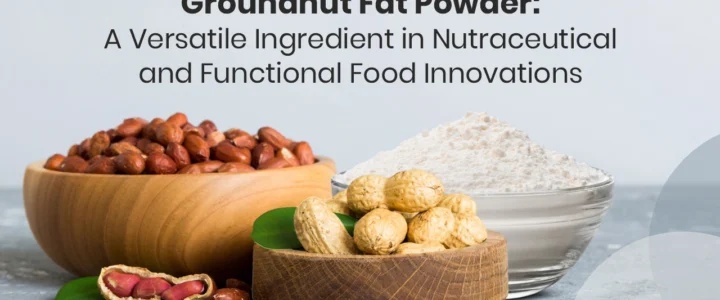Introduction
Since its acceptance as an additional source for healthy fats to form nutraceuticals increases their demand in modern times, groundnut fat powder is the recent versatile addition used in food functionalities and nutritional composition. Nutrients and natural functionality are preserved even after extended stabilization, whereas application in several processes like energy for sports activities through plant-based substitution can now ensure a considerable oxidation resistance together with longer shelf lives compared with conventionally sourced oil. Whether in meal replacements, fortified beverages, or confectionery, it is moulding the future of nutritional fat powders for health-conscious innovation in food and nutraceutical industries.
What is Groundnut Fat Powder?
Groundnut Fat Powder is also known as Arachus Fat Powder and Peanut Fat Powder.
It is spray-dried fat powder derived from refined groundnut oil, in concentrated form providing the powdered material for healthy fats. High content of fat contributes toward effective formulations for nutritional usage in functional food products and dietary supplements.
Since the product differs significantly from standard oils, such nutritional fat powders are better positioned with enhanced stability, better ease of handling, and much more extended shelf life.
Nutritional Value
Adding Arachus Fat Powder in food and nutraceutical formulation has several advantages as follows:
- Healthy Fats Reservoir
Groundnuts contain a rich reserve of monounsaturated & polyunsaturated fatty acids (MUFA & PUFA). Such healthy fats will maintain proper cardiovascular health and lower the inflammation index. In fat powders, nutraceuticals focused on overall wellness must include these healthy fats.
- Rich in Vitamin E and Antioxidants
This fundamental ingredient in Arachus Fat Powder, Vitamin E acts like a natural antioxidant, assisting cells with dealing with oxidative stress and thereby supporting skin, immune and neurological health.
- Energy and Satiety
These types of nutri-fat powder like Arachus Fat Powder are used to manufacture high-energy meal replacements and nutritional supplements with greater endurance, and hence, to be used for better satiety during intake.
Functional Benefits in Food and Nutraceutical Applications
- Enhanced Shelf Stability and Oxidation Resistance
This is one of the main benefits of Arachus Fat Powder, which has less chance of oxidation, thus giving it less chance of rancidity and having longer shelf life in ready-to-eat meals, protein powders, and dry mix formulations.
- Smoother Mouthfeel and Texture
This nutri-fat powder can be added in bakery items, confectionary, and milk substitutes with the creamy mouthfeel without loss of stability that has made it an ideal constituent of functional food.
- Easy Handling and Water Dispersibility
Unlike liquid oils, the Arachus fat powder is water dispersible. It is used in instant beverage mixes, nutritional supplements, and milk substitutes very easily.
- Low Fat Product Application
Food manufacturers today are constantly moving towards lowering levels of trans fats without affecting taste and texture, and this support is brought forward by the development of Peanut Fat Powder towards food product manufacturing not using artificial stabilizers.
Uses
Groundnut Fat Powder is an ingredient with various functions, widely used in a number of formulations in various sectors:
- Nutraceuticals and Nutritional Supplements
It increases the absorption rate of fat-soluble vitamins and other bioactive compounds, therefore the health impact.
- Sports Nutrition and Energy Formulations
It is a significant component in sports drinks, endurance bars, and recovery shakes that provide sustained energy release.
Improves muscle function and metabolic effectiveness of athletes and active lifestyle individuals.
- Infant and Medical Nutrition
Formulation for infant formula and nutritional support for older adults: providing the essential fatty acids necessary for brain development and cognitive function;
Application in various medical nutrition diets of patients having a high calorie, easily absorbed nutritional source.
- Ready-to-drink beverage mixtures and functional food
Improvement of richness and stability in ready-to-drink coffee creamer, tea, health beverages etc. Buildup of nutritional intensification in ready-to-drink fortified beverages.
Why Groundnut Fat Powder Preferred by Food and Nutraceutical Companies
Producers typically choose Arachus Fat Powder when they need a low-cost performance-active ingredient that has stability. It has a long shelf life and low rancidity, hence, reduces storage problems and some supply chain issues. Preservation of the fat powder also ensures that necessary fatty acids and vitamins are preserved, giving maximum health effects. Its blending with both dry and semi-liquid formulations increases efficiency in the process overall.
Future Prospects: Increasing Demand for Nutritional Fat Powders
The international market for nutritional fat powders is expected to increase with the trend for healthy and conditionally fortified foods.
Key trends that shape this market are as follows:
- Increased Plant-Based Nutrition- Rise in the interest for vegan, lactose-free, and dairy alternative products.
- Health and wellness awareness among consumers to embrace heart-healthy fats and nutrient-dense formulations.
- Nutraceutical applications expanded to greater use in sports nutrition, clinical diets, and individualized nutrition solutions.
With its unique functional properties, nutritional benefits and application versatility, Peanut Fat Powder is in a prime position to be highly relevant in future health-driven food innovations.
Conclusion
The use of fat powders for nutraceuticals has been on an increasing trend owing to the rising demand for nutritionally balanced, functionally superior ingredients. Market demand for fat powders in nutraceuticals is developing at the fastest rate because of nutritionally balanced, performance-rich ingredients. Among these, groundnut fat powder has proven as an efficient and versatile solution, providing healthy fats, enhanced stability, improved sensory properties, and matches diverse nutritional and food applications.
Not only is it cost-effective, but it also serves as a high-quality alternative to liquid oils, making it an excellent choice for sports nutrition, bakery products, infant formulas, and dietary supplements. Its functional benefits make it an essential ingredient for modern food formulations. Looking ahead, nutritionists, formulators, and food manufacturers will increasingly turn to groundnut fat powder to create the next generation of functional foods and supplements as the demand for nutritional fat powders continues to rise.










